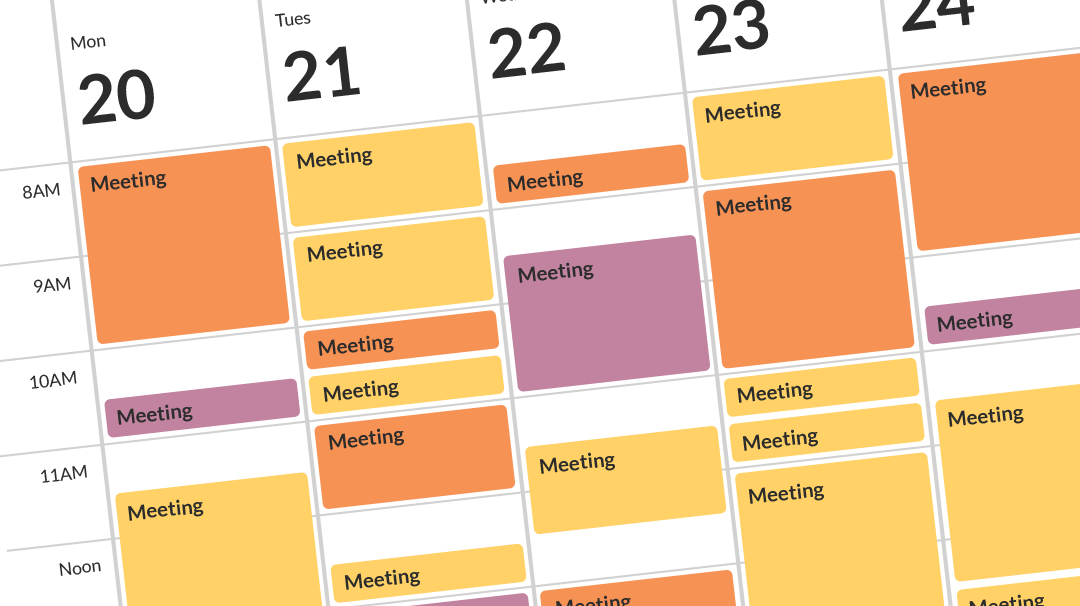
Ah, meetings: imperative for productivity or a total waste of time? Can both be true? Yes, but it doesn’t have to be that way. I’m here to tell you that it is possible to have meetings that leave you feeling energized and ready to take on the world. Seriously. If your meetings are all pain and no gain, this article is for you.
Because once upon a time that’s what meetings were like for us. All talk, no action. Mute on, cameras off. Tabbed out to tab in on anything else. It got to the point that my own mid-meeting routine was all about scrolling copious amounts of Instagram. Because it felt like the most productive thing to do. Been there?
Of course, the mindless scrolling must come to an end. Here’s what you can do to get your meetings trending again. It worked for us, and it will work for you too.
When chaos reigns supreme
Imagine a group of super-smart, like-minded people wandering around aimlessly with no sense of purpose or direction. That was our meetings. Conversations that ebbed and flowed at the whim of those tabbed in. In-person attendees chatting amongst themselves. It may not sound like chaos, but in the context of effective communication, it was chaos of the highest order. We found that these types of meetings were most pronounced when they lacked structure. Here’s our advice:
- Appoint a moderator. If you’re running the meeting, that’s going to be you! Effective meetings need a leader to keep the group on topic, on time, and focused. To keep things moving.
- Set an agenda. Send out a short bullet point summary of what is to be covered ahead of time, so everyone has time to prepare.
- Stick to the plan. If new must-discuss issues or topics start taking over, break them out into separate meetings. This will save a lot of time.
- Keep the group size to a minimum. Conversations get exponentially more complex as group sizes grow. Keep Dunbar’s numbers in mind and only invite only those that need to be there. No more than 8 and your meeting will be great!
- For even more structure, consider following a meeting framework. We’ve successfully integrated components of the Level-10 meeting format into our group meets. You can too.
It’s not a spectator sport
To win the game you need your best players on the field, court, ice, sheet, rink…you get the idea. Too many times in our own meetings our elite players were sitting out. Disengaged. Not a word to be heard. Here’s how we got slam dunks every time:
- Invite the group to suggest meeting talking points ahead of time.
- Get the group warmed up with something fun. Share wins or aha-moments, offer up one-word openers, or ask a question. Use the WIFLE approach to get to the heart of how everyone is feeling. A quick round-robin to kick things off on a positive note makes all the difference. Try this: “The zombie apocalypse is coming, who do you want on your team?”
- Make it collaborative! Use a live document editor, or collaborative tools like Figma to gamify the meeting. A virtual whiteboard with everyone posting and voting on ideas will bring any meeting to life.
- Engage the quiet ones. If your elite players seem distant, pull them back into orbit directly. A simple ask is usually all that’s needed: what do you think?
- Limit distractions. Whether you’re meeting in-person or virtually, you need everyone’s attention. Close tabs, turn off phones, and keep the cameras rolling. Make it mandatory.
- End the meeting with a round of feedback. Get everyone to rate the meeting out loud, from 1 to 10, 1 being the worst game ever, 10 being a total game-changer, with reasons why.
The time suck
Do we need more time at work, or do we need to be more disciplined with our time at work? When 70% of the team is telling you that their productivity has tanked because of meeting time, it’s time to make changes. Because time is money. Consider that a 1-hour meeting with 6 people is 6 hours of productivity time potentially lost. Multiply that by several meetings per day. There’s simply not enough time. So how do you buy time? Here are our top time management tricks that helped us stop the clock:
- Be mindful of the gaps. Smart scheduling is so important. 30-minute gaps between meetings may seem like a good idea, but it’s not enough time to get anything done, and it’s too much time to sit idle. Leave at least an hour between meetings or get them done back-to-back.
- Stopwatch the agenda. If a scheduled topic runs overtime, set up a breakout meeting and move on to the next topic on the agenda. If the meeting itself is about to go overtime, set up a new meeting time. End every meeting on time.
- Only when necessary. “This could have been an email” is probably true. A five minute huddle on Slack can save hours of meeting time. Email gives people time to think before they speak. And just in case you forgot, if you’re all together in the office, just talk.
- Block out focus time. Meetings inevitably create more work, and you need time to get all that work done. To avoid getting caught in an infinite work loop, block off one or two afternoons or a full day per week, and stick to it. Don’t budge. People can work around your schedule.
All talk, no action
Not all meetings go bad! Sometimes they go better than expected. Chock-full of good ideas, aha-moments, and problems solved. At least that’s what it seemed like at the time. But then days go by. Weeks. Months even. And nothing happens. It’s like what happened in the meeting stayed in the meeting. So what exactly did happen? To save you from scheduling a meeting to answer that, here are our lessons learned:
- Have a record keeper. This could be the meeting moderator, or someone else. Their job is to take meeting notes and post those notes for all attendees to see. Use a shared document or team shared folder to give everyone quick and easy access.
- Assign next steps. Reserve some time at the end of the meeting to run through takeaways and next steps. Assign a name beside each, and even better, put dates beside them as well.
- Review next steps. For ongoing projects, be sure to review the previous meeting’s next steps before adding any new steps. This helps set expectations with the group on where things are at and ensures nothing is forgotten or missed.
- Ask for help. Or even better, ask people if they need help. Meetings are a team effort and everyone should be ready to pitch in to get things done.
- Celebrate the wins. Success is a great motivator, so be sure to celebrate even the smallest of wins to keep the momentum going. Pizza parties make anything possible!
Meet? Sweet!
Keep it organized. Encourage engagement. Be mindful of the time. And take action. With a little more structure and a lot more engagement, you’ll turn those mind-numbing Instagram scroll-fests into meetings that everyone wants to attend. The talk of the town. Meetings that really are imperative for productivity and totally not a waste of time!
Get your meetings in sync today.


